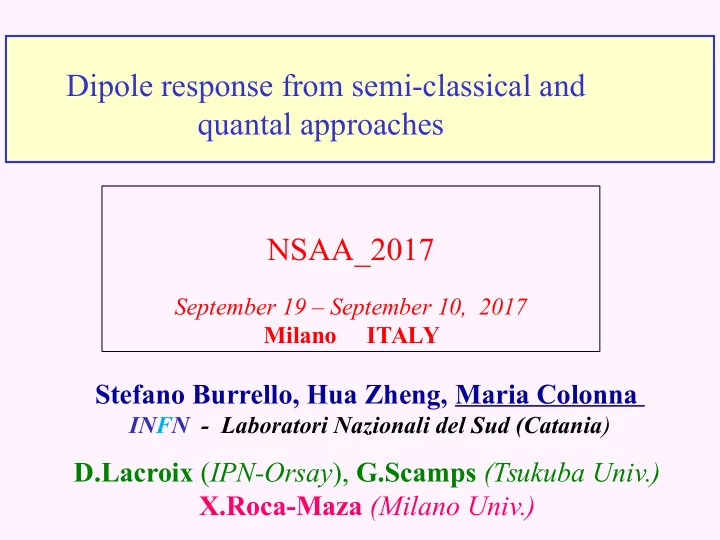

Dipole response from semi-classical and quantal approaches NSAA_2017 September 19 – September 10, 2017 Milano ITALY Stefano Burrello, Hua Zheng, Maria Colonna INFN - Laboratori Nazionali del Sud (Catania ) D.Lacroix ( IPN-Orsay ), G.Scamps (Tsukuba Univ.) X.Roca-Maza (Milano Univ.)
Outline Introduction Brief introduction to quantal dynamical approaches and transport theories: classical vs quantal description Small amplitude dynamics: Dipole excitations: collective nature ? Link to nuclear effective interaction and EOS
Collective modes and effective interaction: some examples Dipole Response in neutron-rich nuclei: o GDR: sensitive to symm. energy E sym o Low-lying strength (PDR) Pygmy dipole strength Isovector dipole response GDR RPA calculations PDR Klimkiewicz et al. X.Roca-Maza et al., PRC 85(2012)
PDR EWSR and Polarizability vs L and neutron skin 0 E sym ( ) S L ... 0 3 0 or J A.Carbone et al., PRC 81,041301(R) (2010) Polarizability exp X.Roca-Maza, X.Vinas et al. RPA Neutron skin calculations vs L
Strength of PDR vs N/Z and neutron skin: Sn isotopic chain S.Ebata et al. TDHFB calculations The neutron skin thickness increases monotonically with N/Z The EWSR exhausted by PDR does not ! Shell effects ?
Dynamics of many-body systems
Dipole oscillations and response functions
Coupling between IS and IV modes TDHF results Skyrme interaction SAMi-J31 132 Sn
Classical vs quantal results: IS and IV response Skyrme interaction SAMi-J31 IS response : - two main low-energy regions (surface modes) - ISGDR IV response : - two main low-energy modes - IVGDR (Goldhaber-Teller) - IV Steinwedel-Jensen IS response IV response
Classical vs quantal results: HF Vlasov IS and IV density profile Skyrme interaction SAMi-J31 Differences in energy of the surface modes (TDHF vs Vlavov) could be associated with the different density profile Shell effects IS and IV density gradients : Larger gradients at the surface in the Vlasov case Larger frequency of the PDR mode
Structure of modes: IS transition densities IV PDR Transition densities: main peaks of the IS response IVGDR 132 Sn ISGDR Skyrme interaction SAMi-J31
IS 100 Sn IV 132 Sn Sn isotopic chain: 100 Sn 120 Sn 132 Sn No PDR in 100 Sn Similar IV PDR strength 120 Sn in 120 Sn and 132 Sn Skyrme interaction SAMi-J31
IV response Structure of modes: “PDR” transition densities neutron skin TDHF results (from IS excitation) Wider neutron osscillation at the surface with SAMi-J35 132 Sn (thicker neutron skin)
IS 120 Sn 100 Sn IV Sn isotopic chain: 100 Sn 120 Sn 132 Sn The low energy IS surface mode is more robust in 120 Sn different density profile 120 Sn Skyrme interaction SAMi-J31
132 Sn 100 Sn Sn isotopic chain: 100 Sn 120 Sn 132 Sn Similar EWSR for PDR in 120 Sn and 132 Sn The low energy IS surface mode is more robust in 120 Sn 120 Sn The ratio IV/IS strength could be a better indicator of the slope L
Conclusions Nuclear excitations in n-rich systems: A way to constrain the nuclear effective interaction. IV response sensitive to symmetry energy details the dipole response can be understood at a semi-classical level but shell effects may influence the initial density profile (low-lying surface modes sensitive to it) in neutron-rich systems, IS and IV responses are connected : isoscalar-isovector coupling --- the PDR is an isoscalar-like mode the PDR strength is related to the neutron skin (i.e. to the symmetry energy slope L), but also to the leading IS strength
symmetry energy PDR and symmetry energy IS response 132 Sn Vlasov IV response S.Burrello et al.
symmetry energy neutron skin PDR and symmetry energy 132 Sn IS response fraction of EWSR in PDR region: Exp: green points Vlasov IV response
Semi-classical calculations with simpler eff. interactions IS (toroidal) response IV response E = 8.9 MeV The low-lying modes are interpreted as surface modes of toroidal shape (the surface moves against the core) M. Urban Velocity fields
IS Structure of modes: transition densities Skyrme interaction SAMi-J31 IV PDR Transition densities: main peaks of the IV response IVGDR 132 Sn IVGDR (S-J) PDR and IVGDR TD are the same for IS and IV excitations !
Recommend
More recommend